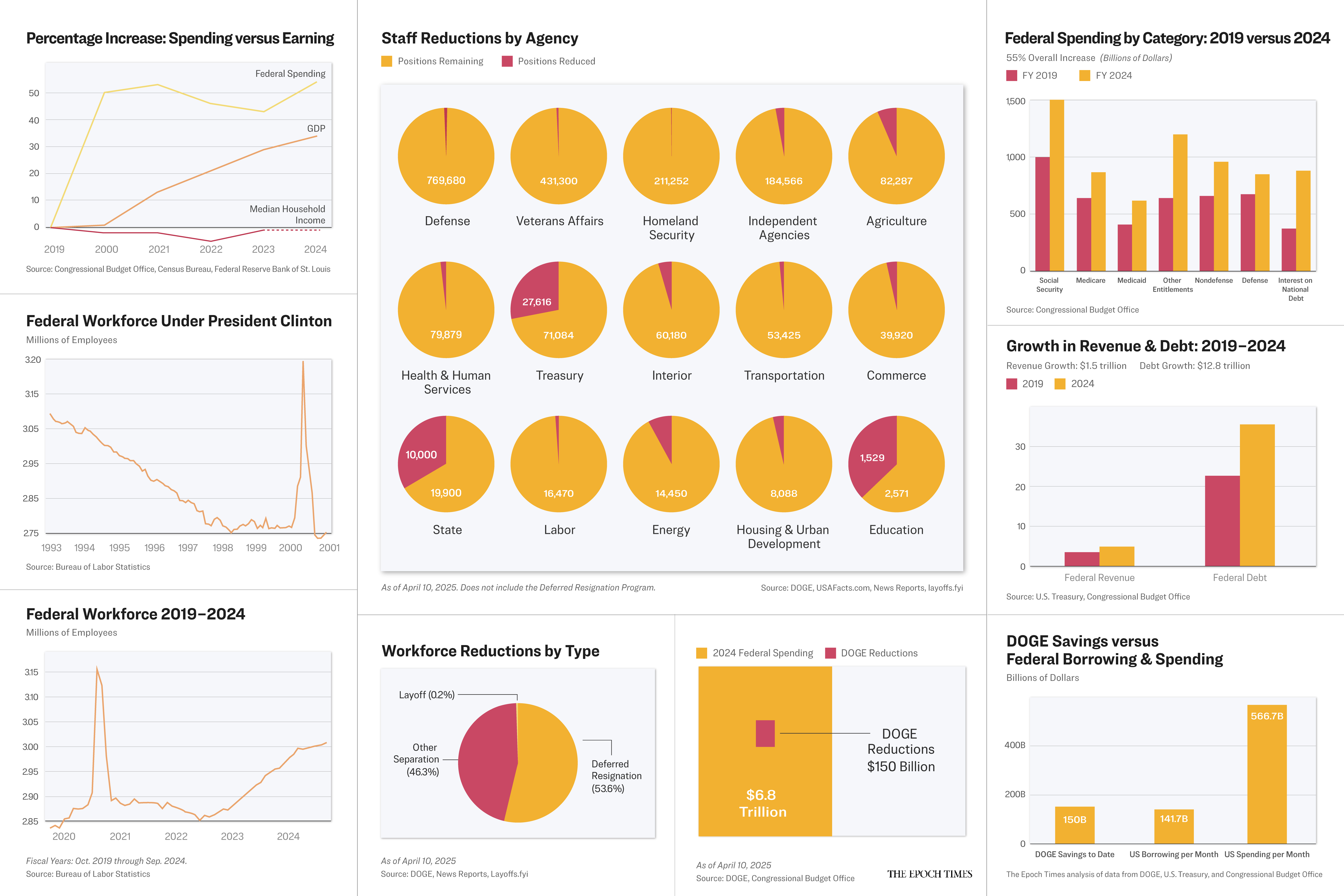It costs more to be an American now than it did five years ago—more than 50 percent more. The U.S. government spent more than half again as much in 2024 as it did in 2019, and interest payments on the national debt more than doubled during that time, according to the Congressional Budget Office.
Since 2019, federal spending, the national debt, and the size of the federal bureaucracy have all grown rapidly. Federal regulations have also increased over the past half-decade, with some 290 additional rules and nearly 10 million words added to administrative law books.
President Donald Trump’s effort to reduce the size and scope of the federal government, mainly through the Department of Government Efficiency (DOGE), has met with some early success. There have also been roadblocks in the form of legal challenges and public protests.
Here is an overview of recent trends in federal spending, borrowing, and staffing that lend perspective to the scope of current and planned reductions to the federal bureaucracy.
Federal spending grew by about 55 percent from 2019 to 2024. The initial increase appears to have been driven by spending related to the COVID-19 pandemic, which trended down beginning in 2021. Yet even before the public health emergency was declared to be over in May 2023, spending began to increase again.
Meanwhile, the median household income in the United States declined slightly over that period. At the end of 2023, the last date for which data is available, the typical U.S. family was earning $600 less per year than in 2019.
Spending grew faster than the nation’s economy, measured as the gross domestic product (GDP)—the total value of all goods and services sold.
The fastest-growing category of federal spending is interest on the national debt, which more than doubled during that period. Interest payments on the national debt (not including repaying the debt itself) now cost more than any single government program except Social Security. The United States pays more to its lenders than it pays for national defense, Medicaid, or Medicare.
Spending on Social Security, Medicare, Medicaid, other entitlement programs, and interest on the debt is mandatory because it is dictated by longstanding federal laws. Other defense and nondefense spending is considered discretionary because Congress sets those amounts each year.
The national debt grew by 56 percent from 2019 to 2024, topping $35 trillion. Since 2012, it has exceeded the value of the United States’ GDP. As of 2024, the federal debt was about 120 percent of the nation’s GDP.
To compare the changes in income and debt over that period in everyday terms, a family earning a household income of $60,000 in 2019 could have increased its salary to $72,000 by 2024. Over the same five years, the family had credit card debt and student loans that increased from $390,000 to $520,000.
The federal workforce grew significantly from 2019 to 2024. Discounting the approximately 500,000 temporary employees hired to conduct the 2020 census, the federal government grew by about 150,000 people during those five years. That increase is more than the total number of people employed by either Boeing or Verizon.
The federal government employs about 3.1 million people, not including the military or federal contractors. Contractors are people employed by private companies to perform work for the federal government, such as processing Medicare claims.
The United States employs more people than Walmart and nearly twice as many people as Amazon. The federal government is the largest employer in 37 states.
Trump is not the first president to reduce the federal workforce. President Ronald Reagan reduced it by 106,000 people during his first year in office, although the workforce grew even larger than it is today over the remainder of Reagan’s tenure.
President Bill Clinton produced a more sustained reduction in the federal workforce. Again discounting temporary census employees, Clinton trimmed the number of federal workers by 35,000 in his first year and 335,000 before leaving office.
DOGE and other executive initiatives have so far attempted to reduce federal spending (not including the military) by eliminating about 137,000 federal workers, or about 4 percent of the federal workforce.
The vast majority of those leaving federal employment have opted into the administration’s deferred resignation program, which allowed them to stop working in March and continue to receive full salary and benefits until Sept. 30, the end of the fiscal year.
Of the other staff reductions, less than 0.5 percent have been involuntary, according to Anthony Armstrong, a Morgan Stanley banker currently working for DOGE.
Armstrong said federal workers have instead been offered voluntary early retirement, voluntary separation agreements, and deferred resignations.
The Trump administration has announced the elimination of about 67,000 federal positions so far, not including the 77,000 workers who opted into the deferred resignation program.
A federal judge ordered that the administration rehire federal workers at the Veterans Affairs, Agriculture, Defense, Energy, Interior, and Treasury departments because of the alleged illegality of the way probationary positions were terminated. However, the Supreme Court has blocked the order from taking effect, leaving the workers on paid administrative leave for now. This involves as many as 24,000 employees or about 36 percent of those not covered by the deferred resignation program.
The DOGE website indicates that about $150 billion in spending reductions were achieved by April 8 through a combination of asset sales, contract and lease cancellations or renegotiations, the elimination of fraud and improper payments, grant cancellations, savings on interest payments, changes to programs, the reduction of federal regulations, and workforce reductions.
That is about 2 percent of federal spending, a little more than the federal government borrows each month.
The eventual goal of $1 trillion in spending reductions would amount to a 14.7 percent reduction in federal spending.











